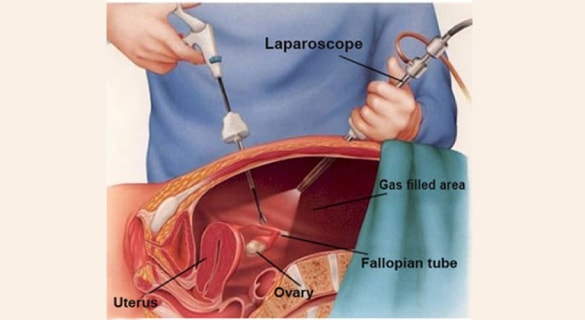Tubal Recanalization
The fallopian tubes are vital components of the female reproductive system and fertility. The fallopian tubes deliver eggs from the ovaries to the uterus, where implantation takes place.
A blocked fallopian tube is a common cause of infertility. The fallopian tubes can become obstructed due to a variety of factors such as infection, Tuberculosis, sexually transmitted disease, uterine fibroids, and scarring after surgery.
Fallopian tube recanalization can be done by minimal invasive technique.

What is Tube Recanalization?
Fallopian tube recanalization is a treatment to address obstructions in the fallopian tubes.
How is the Tube Recanalization procedure performed?
An IV line may be put prior to the treatment to deliver short-acting drugs to reduce pain and help you relax. The doctor starts the process by inserting a speculum into the vagina; a tiny catheter is then inserted through the cervix and into the uterus. A contrast agent (a specific form of dye) is injected and utilized to help fluoroscopy visualise the uterus and fallopian tubes (a type of continuous x-ray technology). If a blockage is discovered, the surgeon will open it. This is performed by inserting a tiny catheter (referred to as a “microcatheter”) through the initial catheter and into the fallopian tube beyond the point of obstruction. When the microcatheter reaches the end of the fallopian tube closest to the ovary, it is progressively withdrawn while a saline solution is pumped via the microcatheter. The saline solution flushes out any debris that has accumulated as a result of the blockage being removed.
When the operation is over, you are usually able to go home within 30 minutes. Some mild spotting may occur for 1-2 days after the treatment, but there should be no extra pain.
When tube recanalization is indicated?
If you have been diagnosed with fallopian tube blockages and/or a history of infertility, endometriosis, or painful intercourse, you may be a candidate for fallopian tube recanalization. Before deciding on a treatment plan, consult with your doctor about all of your symptoms, including a history of pelvic inflammatory disease,pelvic tuberculosis, uterine fibroids, tubal or ovarian abscesses, and other pelvic disorders, to see if you are a candidate for fallopian tube recanalization.Advantages of Fallopian Tube Recanalization
Only local (rather than general) anesthetic is required.
If this is the only cause of infertility, there is a better probability of getting pregnant.
It does not leave scars or cause discomfort, as certain surgical methods can.
When compared to surgery, there is a lower chance of infection.
The treatment is performed on the same day, and the patient recovers at home.
Success rate for tube recanalization
If patency is reestablished during the surgery, which occurs in roughly 65-90 percent of cases, reported conception rates in the literature are around 33%. A tiny percentage of patients’ Fallopian tubes re-occlude and necessitate a repeat surgery 8 months to a year later.What are the possible consequences of fallopian tube recanalization?
Serious problems from Fallopian tube recanalization are extremely rare. Mild bleeding and fallopian tube perforation are possible but normally have no long-term consequences. Infections and contrast responses are also possible, but they are quite infrequent. There is a small increase in the chance of ectopic pregnancy after Fallopian recanalization.
If you are diagnosed with any fallopian tube obstruction or any other infertility issues get an appointment with Dr.ANSHUMALA SHUKLA who is the top gynecologist and Robotic surgeon in Mumbai.
